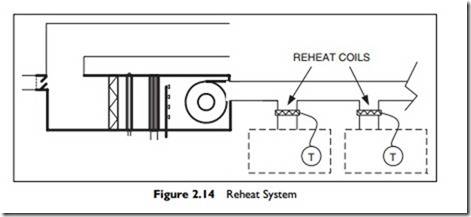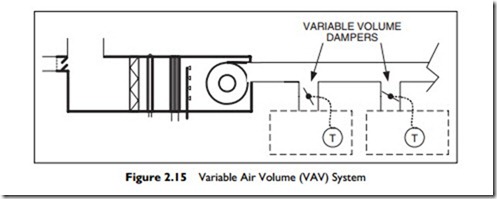Zoned Air-Conditioning Systems
The air-conditioning system considered so far provides a single source of air with uniform temperature to the entire space, controlled by one space thermo- stat and one space humidistat. However, in many buildings there is a variety of spaces with different users and varying thermal loads. These varying loads may be due to different inside uses of the spaces, or due to changes in cooling loads because the sun shines into some spaces and not others. Thus our simple system, which supplies a single source of heating or cooling, must be modified to provide independent, variable cooling or heating to each space.
When a system is designed to provide independent control in different spaces, each space is called a “zone.” A zone may be a separate room. A zone may also be part of a large space. For example, a theatre stage may be a zone, while the audience seating area is a second zone in the same big space. Each has a different requirement for heating and cooling.
This need for zoning leads us to the four broad categories of air-conditioning systems, and consideration of how each can provide zoned cooling and heat- ing. The four systems are
1. All-air systems
2. Air-and-water systems
3. All-water systems
4. Unitary, refrigeration-based systems
System 1: All-air Systems
All-air systems provide air conditioning by using a tempered flow of air to the spaces. These all-air systems need substantial space for ducting the air to each zone.
The cooling or heating capacity, Q, is measured in British Thermal Units (Btu) and is the product of airflow, measured in cubic feet per minute, (cfm), times the difference in temperature between the supply air to the zone and the return air from the zone.
Q (Btu) = Constant · mass flow · temperature difference Q (Btu) = Constant · cfm · (°Fzone – °Fsupply air)
To change the heating or cooling capacity of the air supply to one zone, the system must either alter the supply temperature, °F, or alter the flow, cfm, to that zone.
Reheat system: The simplest, and least energy efficient system, is the constant volume reheat system. Let us assume that the main air system provides air that is cool enough to satisfy all possible cooling loads, and that there is a heater in the duct to each zone.
A zone thermostat can then control the heater to maintain the desired zone set-point-temperature. The system, shown in Figure 2.14, is called a reheat system, since the cool air is reheated as necessary to maintain zone temperature.
Figure 2.14 illustrates the basic air-conditioning system, plus ducting, to only two of many zones. The air to each zone passes over a reheat coil before entering the zone. A thermostat in the zone controls the reheat coil. If the zone requires full cooling, the thermostat will shut off the reheat coil. Then, as the cooling load drops, the thermostat will turn on the coil to maintain the zone temperature.
Variable Air Volume (VAV) System: Figure 2.15 illustrates another zoned system, called a Variable Air Volume system, VAV system, because it varies the volume of air supplied to each zone.
Variable Air Volume systems are more energy efficient than the reheat systems. Again, assume that the basic system provides air that is cool enough to satisfy all possible cooling loads. In zones that require only cooling, the duct
to each zone can be fitted with a control damper that can be throttled to reduce the airflow to maintain the desired temperature.
In both types of systems, all the air-conditioning processes are achieved through the flow of air from a central unit into each zone. Therefore they are called “all-air systems.” We will discuss these systems in a bit more detail in Chapter 7. However, to design and choose systems, you will need the detailed information found in the ASHRAE course Fundamentals of Air System Design2.
System 2: Air-and-water Systems
Another group of systems, air-and-water systems, provide all the primary ventilation air from a central system, but local units provide additional conditioning. The primary ventilation system also provides most, or all, of the humidity control by conditioning the ventilation air. The local units are usually supplied with hot or chilled water. These systems are particularly effective in perimeter spaces, where high heating and cooling loads occur. Although they may use electric coils instead of water, they are grouped under the title “air-and-water systems.” For example, in cold climates substantial heating is often required at the perimeter walls. In this situation, a hot-water-heating system can be installed around the perimeter of the building while a central air system pro- vides cooling and ventilation.
System 3: All-water Systems
When the ventilation is provided through natural ventilation, by opening windows, or other means, there is no need to duct ventilation air to the zones from a central plant. This allows all processes other than ventilation to be pro- vided by local equipment supplied with hot and chilled water from a central plant. These systems are grouped under the name “all-water systems.”
The largest group of all-water systems are heating systems. We will introduce these systems, pumps and piping in Chapters 8 and 9. The detailed design of these heating systems is covered in the ASHRAE course Fundamentals of Heating Systems3.
Both the air-and-water and all-water systems rely on a central supply of hot water for heating and chilled water for cooling. The detailed designs and calculations for these systems can be found in the ASHRAE course Fundamentals of Water System Design4.
System 4: Unitary, Refrigerant-based Systems
The final type of system uses local refrigeration equipment and heaters to provide air conditioning. They are called “unitary refrigerant–based systems” and we will discuss them in more detail in Chapter 6.
The window air-conditioner is the simplest example of this type of system. In these systems, ventilation air may be brought in by the unit, by opening windows, or from a central ventilation air system.
The unitary system has local refrigerant-based cooling. In comparison, the other types of systems use a central refrigeration unit to either cool the air- conditioning airflow or to chill water for circulation to local cooling units.
The design, operation and choice of refrigeration equipment is a huge field of knowledge in itself. Refrigeration equipment choices, design, installation, and operating issues are introduced in the ASHRAE course Fundamentals of Refrigeration5.
System Control
We have not yet considered how any of these systems can be controlled. Controls have become a vast area of knowledge with the use of solid-state sensors, computers, radio and the Internet. Basic concepts will be introduced throughout this text, with a focused discussion in Chapter 11. For an in-depth introduction to controls, ASHRAE provides the course Fundamentals of HVAC Control Systems6.

